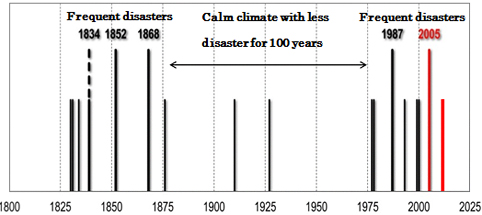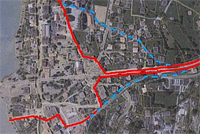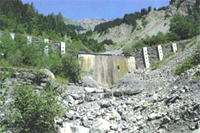About Us
Learning from Switzerland
I stayed in Switzerland for a few days on the way back from Brussels where I participated in EU-JICA Seminar on "Building Resilience: Lessons from Post-Tsunami Japan". Taking this opportunity I made a one-day trip to Brienz on 12 March 2013 to see sabo works and rehabilitation works after debris flows in 2005.
Despite very tight schedule I could see excellent practices, which I thought should be shared with ISN members. The following is a brief report on the field trip. The trip was possible thanks to Mr. Andreas Goetz, Vice Director of Federal Office for Environment and Mr. Oliver Hitz, Hydraulic Engineer, Civil Engineering Office of Canton Bern.
The first is a historical review of disasters and settlements. Brienz is located on alluvial cones of several torrents. The review found a cyclic change in disaster occurrence in the past: Frequent disasters in 1830-1875, relatively calm climate with less disaster for the subsequent 100 years, and again frequent disasters since 1975 onward (Fig.1).
Federal Government started actions for disaster reduction including legislation (Sabo Law in 1877) and countermeasures as its own responsibility since late 1870s; As for people, they lived originally away from the torrents, but settlements developed into flood prone areas towards the end of 20th century.
 Fig.1 Cyclic change in disaster occurrence
Fig.1 Cyclic change in disaster occurrence
 Fig.2 Flooding area in 2005
Fig.2 Flooding area in 2005
along Trachtbach Torrent
Blue line : Inundated area
Red line : Area where houses
were heavily damaged
Heavy damages in recent years are apparently due to the dense settlements in flood prone areas (Fig.2). The time span of 100 years of less disaster might be enough for people to forget the risk. Too much reliance on government might also be another factor for such development of settlement. Now, hazard maps have been prepared for all these torrents to regulate further development of settlements in flood prone areas.
Forgetfulness by nature of human beings and reliance on government as the tendency of people are problems common to all countries as ISN members may be experiencing in each country. Japan is not an exception as experienced in the case of the East Japan Earthquake/Tsunami Disaster in 2011.
The second is the assessment of strength/safety of old sabo dams. A total of 20 sabo dams were constructed in Lammbach torrent with stone masonry during 1896-1913. According to a previous study the lifespan of such construction should be 60-80 years, maximum 100 years, indicating that most sabo dams in the Lammbach were exceeding the lifespan.
 Fig.3 Reinforcement works
Fig.3 Reinforcement works
in Lammbach torrent
In addition, the foundations with wooden grids/piles were also concerned about.
Assessment was carried out by Lucerne University of Applied Science and Arts/National Platform for Natural Disasters in 2010.
Following the assessment, reinforcement works were carried out for structures as required (Fig.3). Despite uncertainties in the assessment due to lack of data at the time of construction etc. the assessment could provide practical solutions to the problem of deteriorating sabo structures.
"Deteriorating infrastructure" is a serious problem common to most countries. Japan is not an exception in this case too, where a number of infrastructure were constructed in the past in pace with the economic development, and now many are reaching/exceeding their lifespan. In fact, a serious accident occurred in an express highway tunnel last year due to deterioration of materials, and the government started nationwide assessment of the safety of infrastructure to begin with major tunnels and bridges.
Assuming that the issue of "deteriorating infrastructure" will become more serious worldwide in the future, I hope "sabo" will lead various infrastructure sectors in the safety assessment and required reinforcement. In this connection I hope, as the next step, assessment method will be developed for structures other than stone masonry construction. It is to be noted that construction of concrete sabo dams began in early 20th century. In Japan for example the first one was in 1916, nearly a century ago.
Switzerland might be the forerunner in the safety assessment of old sabo structures, but if similar practice has been done or is considered in any ISN member's country please let us know, for information exchange and for discussion on way forward.
March 2013
Hidetomi Oi
President, International Sabo Association